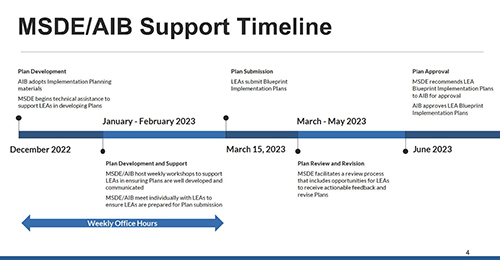Maryland’s Blueprint for the Future
Supporting the Recommendations of the Kirwan Commission
Jump to: Overview | Updates | Feedback | Early Childhood | Diverse Staff | College and Career | Student Success | Governance | Funding
Overview
In 2021, the Maryland State Legislature passed the Blueprint for Maryland’s Future, legislation that codified the recommendations of the Maryland Commission on Innovation and Excellence in Education (Kirwan Commission). This law aims to:
- Transform Maryland’s public schools into a world-class system of education by expanding early access to education;
- Remodel teaching into a high-status profession and incentivize teachers to pursue professional development while maintaining focus on classroom instruction;
- Enable most students to achieve college and career readiness by the end of 10th grade;
- Broaden resources to ensure all students are successful, including students with disabilities, students who are English learners, and students living in poverty; and
- Create an accountability framework to evaluate compliance with the Blueprint’s mandates, determine effectiveness of student learning, and identify areas where the State can support the local school systems as they implement these programs.
The Blueprint will be implemented over the course of the next 10 years. Howard County Public School System (HCPSS) staff have been meeting since September to plan how the school system will meet these goals in a manner that is programmatically appropriate and fiscally responsible.
HCPSS Blueprint Updates
HCPSS has submitted its initial draft of the Blueprint Local Implementation Plan to the Maryland State Department of Education (MSDE) and the Accountability and Implementation Board (AIB). The plan, which covers the 2021-2022 through the 2023-2024 school years, consists of HCPSS’ responses to 164 question prompts covering the five pillars of the Blueprint: early childhood education, high-quality and diverse teachers and leaders, college and career readiness, more resources for students to be successful, and governance and accountability.
Within each pillar, HCPSS has outlined how it will meet the requirements put forth by MSDE in accordance with the Blueprint for Maryland’s Future. HCPSS’ plan highlights the expansion of full-day pre-K; recruiting a more diverse workforce; expanding career and college readiness pathways; offering more supports to students who are English learners, have disabilities, or need more health and mental health supports; and planning for stakeholder engagement.
HCPSS provided an update on the initial draft plan to the Howard County Board of Education at its March 9 meeting.
Blueprint Update, December 15, 2022
In collaboration with MSDE, the Accountability and Implementation Board (AIB) has released the final Blueprint Implementation Plan template. The initial plan draft covers the first 2 years of implementation. In the PowerPoint, staff will provide an overview of how the draft will be composed, the plan for stakeholder input, and the timeline for submitting by March of 2023. A second part of the plan will be due by March of 2024.
The Maryland State Department of Education (MSDE) and the Accountability and Implementation Board (AIB) are jointly releasing a template and a Criteria for Success that each local education agency (LEA) will use to develop and submit its initial Blueprint Implementation Plan.
The AIB Comprehensive Plan is being edited by AIB staff and will be available in December at: https://aib.maryland.gov/Pages/Blueprint-plans.aspx

Local ESSA Plan & Blueprint Update, November 3, 2022
For the 2022 Local ESSA Consolidated Strategic Plan, MSDE has produced a simplified template to reduce duplication with other grant and Blueprint reporting. The Local ESSA Consolidated Strategic Plan typically includes appendices of grant applications for Title I, Title II, Title III, and Title IV funds awarded from the state. 2022 grant applications are being processed separately by MSDE and will come through the consent agenda. In the PowerPoint, staff will review the requirements of the Local ESSA Consolidated Strategic Plan and the timeline to submit the plan prior to the December 15th deadline.
In collaboration with MSDE, the Accountability and Implementation Board (AIB) has released the Blueprint Implementation Plan requirements. The initial plan draft covers the first 2 years of implementation. In the PowerPoint, staff will review the requirements of the Blueprint Implementation Plan and the timeline to submit the plan prior to the March 2023 deadline.
Focus Areas / Pillars
The Blueprint for Maryland’s Future is organized into five distinct pillars: early childhood education, high-quality and diverse teachers and leaders, college and career readiness, resources to ensure all students are successful, and governance and accountability. See below for details on each pillar.
Early Childhood Education
The Blueprint establishes a significant expansion of free full-day prekindergarten to low income families so that all children have the opportunity to begin kindergarten ready to learn. Prekindergarten will be free for all 3- and 4-year- olds whose parents meet income eligibility requirements and will be available on a sliding scale to all other 4-year- old students.
In order to support such expansion, the Blueprint will provide funding to both public and community-based early education programs that meet rigorous quality standards. Expansion will be an ongoing process, as it requires adjustments to early education preparation programs, increases to physical and staff capacity, and demonstration of quality and continuous improvement as measured by a quality rating system.
A Closer Look at the HCPSS Pre-K Experience, February 27, 2023

High-Quality and Diverse Teachers and Leaders
The Blueprint raises the status of the teaching profession and encourages professional development through a performance-based Career Ladder with salaries comparable to those in other professional fields with similar education requirements. Local educational agencies will work with their bargaining units to create a Career Ladder that recognizes effective teachers and school leaders and incentivizes them to stay in the classroom. Advancement up the ladder is based on the acquisition of specified knowledge and skills, rigorous evidence of success as a classroom teacher, and willingness to take on leadership responsibilities.
By increasing the rigor of teacher preparation programs and raising compensation to be more comparable to that expected in other professions, it is hoped that Maryland will create and sustain a teaching faculty that reflects the diversity of the public school student population.

Teacher salary progression and classroom performance will be linked to teacher achievement of National Board Certification (NBC). HCPSS is prepared to expand existing programs to support its teachers who are pursuing NBC and looks forward to increasing the number of NBC teachers in all of its schools.
College and Career Readiness Pathways
Maryland public schools will use their internationally benchmarked curricula to facilitate most students achieving “College and Career-Ready” status by the end of 10th grade. CCR status will be aligned with global standards to ensure students have the literacy and mathematics skills to succeed in first-year Maryland community college courses.
Students who achieve CCR will have the opportunity to pursue no-fee pathways that include earning up to 60 credits at Howard Community College, enrolling in competitive entry college programs such as Advanced Placement (AP) courses, and/or earning industry-recognized credentials that prepares students to join highly-sought and well-paid professions.
To provide ample opportunities to students who achieve CCR status by the end of 10th grade, HCPSS will provide free access to the 60 credit JumpStart dual enrollment program, expand its Career and Technical Education Career Academy offerings, both at the ARL and high schools, and increase supports for students taking AP exams. HCPSS will also expand elementary, middle, and high school interventions, during and beyond the school day/year, to help struggling learners develop the necessary literacy and mathematical skills to graduate college and career ready.
Dual Enrollment Gives Students a “JumpStart” on College, March 8, 2023
Inside HCPSS Podcast Episode 3 – Dual Enrollment, February 23, 2023
Resources to Ensure All Students are Successful
The Blueprint supports all students being successful in school by increasing funding based on the numbers of students with IEPs, who receive ESOL services, and/or who live in poverty. Schools that have high concentrations of poverty, measured by the number of students receiving Free and Reduced Price Meals (FARMs) or through other factors, will be provided additional funding to transform into community schools offering wraparound services for students and their families. These services may include:
- extended day programs
- access to health, vision, and dental services
- additional behavioral health supports
- family and community engagement programming
The Blueprint also requires school systems to address
the negative impacts of traumatic events, including the COVID–19 pandemic and school closures.
Additional funds are also available to support reading and literacy instruction in Grades K–3 through universal screening and small group tutoring or instruction. Mathematics supports can also be provided for struggling learners in the primary grades.
Governance and Accountability
The Blueprint establishes an accountability-oversight board that has the authority to ensure that the Commission’s recommendations are successfully implemented and produce the desired results. This board will have a more direct role in shaping how the Blueprint is put into action once it secures funding and personnel support.
HCPSS has created five workgroups representing each Blueprint major initiative, which have analyzed the legislation, identified needed clarifications, established timelines for implementation, and begun to budget the fiscal impacts of both the Blueprint’s additional funding and its new mandates.
HCPSS staff have been collaborating with the Maryland State Department of Education and neighboring school systems to build common understandings of ambiguities in the legislation and share best practices and next steps.
While the promise of the Blueprint for Maryland’s Future
is immense, there are still many logistical hurdles that
will need to be navigated. Not least among these is obtaining sufficient funding to both meet the Blueprint’s requirements and provide all students with the quality well-rounded educational opportunities that they and their families have come to expect.
Funding
Funding Formulas and Costs
The programmatic goals to advance Maryland’s public education as a world-class system will require substantial increases in costs over the next 10 years. Understanding that the existing funding formulas would not align with generating sufficient revenue to support increased costs, the Blueprint overhauls the funding formulas.
Maryland’s education funding formulas are rooted in the principle of per pupil funding with safeguards established that do not allow the funding per pupil to decrease year over year. The basic components of the funding formulas are: an established baseline per pupil funding level; an enrollment count basis; and an allocation of the funding share between the state and county. The Blueprint makes modifications in each of these areas. More specifically, it revises the methodology for calculating enrollment, establishes new per pupil funding levels for major aid program areas, and broadens the calculation of the required state and county share of the funding applying it to the major aid programs. These changes are phased-in and modulated over the next 10 years. Initial projections by the Department of Legislative Services indicate that the formula changes will require state funding to grow.

